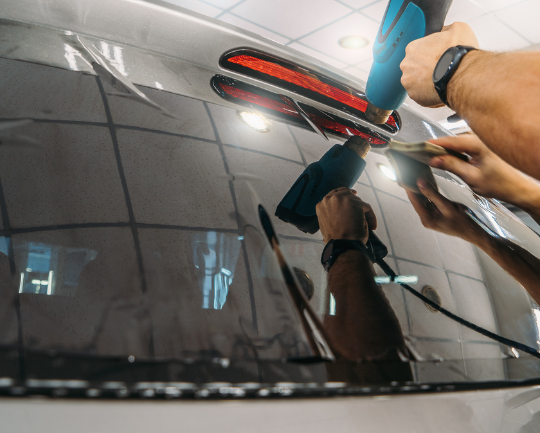Choosing The Right Tint For Your Glass Type
Choosing the right tint for your glass type can significantly impact your space’s aesthetics, comfort, and energy efficiency. Whether you’re tinting the windows of your home, car, or office, understanding the characteristics of different glass types is crucial to making an informed decision. In this guide, we’ll delve into the various types of glass commonly used in architectural and automotive applications and explore the tinting options best suited for each.
Glass types vary in composition and structure, which can affect how well they accept and retain tint. Float glass, the most common type used in windows and doors, is relatively easy to tint and offers a wide range of options for heat rejection and UV protection. Tempered glass, known for its strength and safety features, presents some limitations for tinting but can still benefit from certain types of films for added privacy and aesthetic appeal. Laminated glass, often used in windshields and skylights, offers enhanced security and noise reduction benefits when tinted.
Factors such as sunlight exposure, privacy needs, and climate considerations also play a role in determining the most suitable tint for your glass type. By understanding these factors and the tinting options available, you can make an informed decision to enhance your space’s comfort, privacy, and energy efficiency.
Understanding Glass Types
Understanding the different types of glass is crucial when it comes to choosing the right tint for your windows. There are several common types of glass used in residential and automotive applications, each with its own characteristics and considerations for tinting.
Float glass, also known as annealed glass, is the most common type of glass used in windows. It is made by floating molten glass on a bed of molten metal to create a smooth surface. Float glass is relatively easy to tint and offers good optical clarity, making it suitable for a wide range of tinting applications. However, it is not as strong as other types of glass and can be prone to breakage.
Tempered glass is much stronger than float glass and is often used in applications where safety is a concern, such as car windows and shower doors. Tempered glass is heat-treated to increase its strength and shatter resistance. While tempered glass can be tinted, the tinting options are limited compared to other types of glass.
Laminated glass is made by sandwiching a layer of polyvinyl butyral (PVB) between two or more layers of glass. This process creates a strong, durable glass that is resistant to shattering. Laminated glass is often used in applications where safety and security are paramount, such as car windshields and storefronts. Laminated glass can be tinted, but the process is more complex than tinting other types of glass.
Overall, understanding the different types of glass and their characteristics is essential when choosing the right tint for your windows. Consider factors such as strength, safety, and tinting options to ensure that you select the best tint for your needs.
Tinting Options For Various Glass Types
- Float Glass:
- Best Practices: Float glass, commonly found in windows, is well-suited for tinting. Look for high-quality tint films that offer UV protection and effective heat rejection.
- Considerations: Ensure the tint film you choose is specifically designed for float glass. This will help prevent adhesive issues and ensure the longevity of the tint.
- Tempered Glass:
- Limitations: Tinting tempered glass can be challenging due to its surface hardness and the tempering process it undergoes. Specialized tint films and professional installation are highly recommended.
- Recommendations: Option for lighter shades of tint for tempered glass to reduce the risk of stress on the glass. Additionally, use tint films that are explicitly designed for use on tempered glass to ensure compatibility.
- Laminated Glass:
- Benefits: Laminated glass, which consists of multiple layers of glass with an interlayer of polyvinyl butyral (PVB) or ethylene-vinyl acetate (EVA), offers enhanced security and noise reduction properties. It is also suitable for tinting.
- Tinting: When tinting laminated glass, choose tint films that provide UV protection and effective heat rejection. It’s essential to ensure that the tinting process does not compromise the integrity of the laminate layers.
Each type of glass has its unique characteristics and requirements when it comes to tinting. Consulting with a professional tinting service is highly recommended to ensure that you select the right tint film and installation method for your specific glass type.
Factors To Consider
- Sunlight Exposure: The amount and direction of sunlight your windows receive can impact the type of tint you need. For windows that receive direct sunlight, you may want a tint that offers higher heat rejection and UV protection.
- Privacy Needs: Consider how much privacy you require. Some tints offer increased privacy during the day without significantly affecting visibility from the inside.
- Climate Considerations: If you live in a hot climate, you might prioritize heat rejection properties in your tint. In colder climates, you may want a tint that helps retain interior heat.
- Glass Type: Different types of glass may have specific tinting limitations or requirements. For example, tempered glass may not be able to withstand certain installation processes.
- Legal Regulations: Check local regulations regarding tint darkness and reflectivity, as these can vary by region.
- Aesthetic Preferences: Tint films come in various shades and colors. Choose one that complements the look of your home or vehicle.
- Budget: Tinting costs can vary based on the type of tint and the size of the area to be tinted. Consider your budget when selecting a tint.
Popular Tint Types For Different Glass
- Ceramic Tint:
- Float Glass: Ideal for heat rejection and UV protection.
- Tempered Glass: Provides excellent heat rejection and UV protection, enhancing safety and aesthetics.
- Laminated Glass: Offers enhanced security, noise reduction, and UV protection.
- Carbon Tint:
- Float Glass: Known for its durability and color stability, offering good heat rejection and UV protection.
- Tempered Glass: Provides similar benefits as for float glass, enhancing safety and aesthetics.
- Laminated Glass: Offers added security, noise reduction, and UV protection.
- Metalized Tint:
- Float Glass: Suitable for applications where high heat rejection is desired but may interfere with electronic devices.
- Tempered Glass: Can be used but may interfere with electronic devices.
- Laminated Glass: Provides added security, noise reduction, and some degree of heat rejection.
These are general guidelines, and the suitability of each tint type may vary based on specific glass types and individual requirements. Consulting with a professional installer is recommended for personalized recommendations.
 Installation Considerations
Installation Considerations
- Professional Installation: Emphasize the importance of hiring a professional for installing tint on various types of glass. Professionals have the expertise and tools to ensure proper application and avoid common issues like bubbling, creasing, or peeling.
- DIY Options: Mention that while some DIY tint kits are available, they may not be suitable for all glass types. DIY kits often lack the quality and durability of professional-grade tints, leading to potential issues with application and longevity.
- Safety Precautions: Highlight the importance of safety precautions during installation, such as wearing protective gear and working in a well-ventilated area. Certain types of glass, like tempered glass, can shatter if not handled properly.
- Surface Preparation: Explain the need for thorough cleaning and preparation of the glass surface before applying tint. Any dirt, dust, or residue can affect the adhesion and appearance of the tint.
- Adhesive Selection: Discuss the importance of choosing the right adhesive for the specific type of glass. Different types of glass may require different adhesives to ensure proper bonding and longevity of the tint.
- Application Techniques: Provide basic guidelines for applying tint, such as using a squeegee to remove air bubbles and ensuring even application. Different glass types may require different application techniques for best results.
- Curing Time: Explain the importance of allowing the tint to cure properly before exposing it to water or cleaning agents. Curing times can vary depending on the type of tint and environmental conditions.
- Post-Installation Care: Advise readers on how to care for tinted glass after installation, such as avoiding abrasive cleaners and harsh chemicals that can damage the tint. Provide tips for maintaining the tint’s appearance and longevity.
Maintenance Tips
- Gentle Cleaning: Use a mild soap or specialized glass cleaner with a soft cloth to clean the tinted glass. Avoid abrasive cleaners or rough materials that could scratch the tint.
- Avoid Harsh Chemicals: Refrain from using ammonia-based cleaners or abrasive materials, as they can damage the tinted surface.
- Soft Tools: Use soft materials such as microfiber cloths or squeegees to clean the glass, avoiding anything that could scratch or damage the tint.
- Regular Inspection: Periodically check the tint for any signs of damage, peeling, or bubbling. Promptly address any issues to prevent further damage.
- Avoid Sharp Objects: Be careful when placing objects near tinted glass to avoid scratches or punctures that could damage the tint.
- Protection from Sunlight: Use curtains, blinds, or window coverings to protect tinted windows from prolonged direct sunlight, which can cause fading or damage to the tint.
- Professional Inspection: Schedule regular inspections with a professional tint installer to assess the condition of the tint and address any maintenance needs.
Choosing the right tint for your glass type is crucial for achieving the desired benefits, whether it’s enhancing privacy, improving energy efficiency, or protecting against UV rays. Understanding the different types of glass and their characteristics can help you make an informed decision when selecting a tint. Factors such as sunlight exposure, privacy needs, and climate considerations should all be taken into account.
By selecting the right tint for your glass type, you can enjoy a range of benefits, including increased comfort, improved energy efficiency, and enhanced aesthetics. Proper maintenance is also essential to ensure the longevity of your tinted glass. By following these maintenance tips, you can keep your tint looking great for years to come.
Ready to enhance your home or vehicle with the perfect tint? Contact us today to learn more about our tinting services and schedule a consultation. Our team of experts can help you choose the right tint for your glass type and ensure a professional installation. Don’t wait—take the first step towards enjoying the benefits of tinted glass today.




